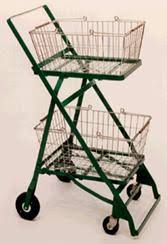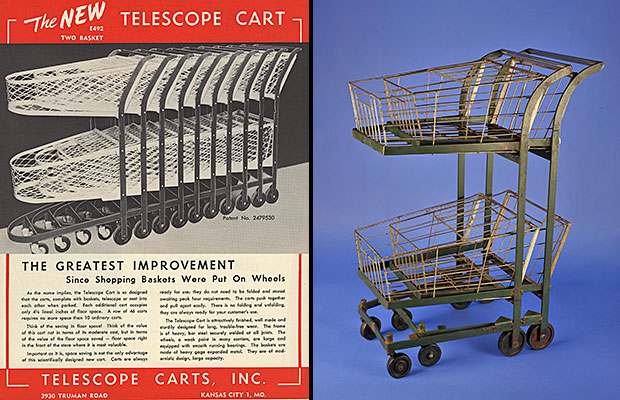As I was shopping last week, I noticed the shopping cart I was using was in really good shape. There were no wheels spinning wildly out of control, the wheel alignment was so good that the cart didn’t veer off to the right, and there was no tattered store circular or crumbled, expired coupons spread out all over the cart.
Also, a young woman who worked at the store had enthusiastically wiped down my cart (especially the handle) with a disinfecting wipe before I took possession of it. I knew then I was going to have a great shopping experience! LOL
What Would We Do Without Shopping Carts?
This, naturally, got me thinking about shopping carts. In particular, the history of shopping carts. Who had the bright idea in the first place?
A little research turned up the answers I was looking for.
In 1936, Sylvan Goldman was the owner of several Standard/Piggly Wiggly grocery stores in Oklahoma. At the time, the stores supplied shoppers with a small wooden or wire basket for them to carry as they wandered up and down the aisles.
Once the basket got too heavy, though, customers headed for the check-out line, which was a situation Goldman wanted to avoid. To keep them buying, Goldman was determined to figure out a way to make heavy baskets more manageable, according to mentalfloss.com.
Shopping Cart 1.0
Then, one night he happened to look at a wooden folding chair and had his eureka! moment.
Goldman and a young mechanic who worked for him named Fred Young placed one shopping basket on the seat and another under the chair, then added wheels to the legs, and a handle on the back. After spending a few months tinkering with the design, the first shopping cart was ready for action.

Unfortunately, Goldman’s shoppers weren’t yet ready to embrace this new technology. Women said they had pushed enough baby carriages and didn’t want to do that when shopping. And men were too proud to admit they needed help carrying a basket.
So Goldman came up with a psychologically inventive solution. He hired men and women to push carts around the store and pretend to shop. When real customers came into the store, they saw people using the carts and decided to also use them. Nothing like the power of a little peer pressure!
Shopping Cart 2.0
The next great innovation was developed by Orla Watson, who, in 1947, made the baskets permanently attached to the cart, and redesigned them to have a hinged back, allowing each basket to nest inside another one for easy storage, according to mentalfloss.com.

Shopping Cart 3.0
Then, in the 1950s, the shopping cart we all know and love – the one with a big basket, was introduced. Following that, a few new things were added, like the baby seat, drink holders, the plastic handle, even bigger baskets, and upgraded wheels.
Shopping Cart Fun Facts!
Here are some other interesting facts about shopping carts, according to mentalfloss.com:
- Carts generally cost between $100 and $150 each.
- Almost every major city has one or more companies whose sole business is to retrieve and return abandoned carts to their rightful owners for a small fee.
- The American Academy of Pediatrics (AAP) reported that 20,700 kids under 5 years old were treated in hospital emergency rooms for shopping cart-related accidents in 2005. About 75% of these injuries were to the head or neck with about 85% occurring after a kid fell out of the cart or caused the cart to tip over.
- With the exception of the automobile, the shopping cart is the most commonly used “vehicle” in the world: some 25 million grace grocery stores across the U.S. alone (according to priceonomics.com).
- Carts typically last about 10 years.
- The digital shopping cart icon is now on thousands and thousands of websites across the Internet.
So when you think of a shopping cart, please think of recording your purchases – whether you buy something from a food/grocery store, some other retail store, or online.
Thanks, and have a great weekend!
Best Regards,
Taylor
Also see:
- What’s The Best Time/Day To Go Grocery Shopping? (October 22, 2020)




I enjoyed learning the story behind the shopping cart. I’m always fascinated by inventions. Your blogs are really great. Thank you.
Very interesting history of the shopping cart Taylor. I especially liked the way the storekeeper hired people to pretend they were shopping in order for the public to see how well the carts we worked this getting them to want to use them.
Smart thinking!
I had never heard the history of the shopping cart. I found it to be fascinating. When I was a very young child, I used to go do shopping for my next door neighbors. There were 3 ladies who lived next door from me. My parents owned the home and I would do light grocery shopping for them. I was only about 7 or 8 at the time. I would go to the store for them every week. I don’t recall who eventually brought me a wagon to stop me from making multiple trips in 1 day. I was very grateful for that shopping cart because there was no way I would have been able to shop for everyone at one time.
Great story thank you Taylor
Thank u very informative. I enjoy ur blogs